by Terra Anders Pigeons, crows, grackles and blackbirds are all well known for their frequent gathering and roosting on rooftops, gutters, air conditioning vents and other structures. This problem affects private homes, public establishments and businesses. Pigeon control is important, not only because of the damage their feces causes to finishes and paint, but also because of the disease that the bacteria and small parasites in their feces may carry. Businesses may find that customers avoid their establishment if these birds are allowed to remain unchecked. These birds do deserve to set down and rest once in awhile, but having them settling in on your property means dealing with quite a mess. Controlling pest birds, like pigeons, does not have to be complicated or harmful to their health. There are several humane bird deterrent methods that can be used quite effectively to send these birds on their way. Any one of these methods can be used without the need for complex or expensive installation. Bird netting can be used when you want to keep birds away from flowers and crops, or from gaining access to any valuable structures. This type of netting is not used to trap the birds, but to keep birds out of a specific area. The most common use of netting is in orchards, vegetable gardens, and vineyards, but it can also be use indoors in larger structures where birds can fly in, and nest up high in the ceiling beams. Most netting is made with knotted strands of plastic cord, and is available in several thicknesses. Lightweight netting is often used indoors to stop bird pests from nesting inside large warehouses, hangers, or tunnels. Heavy-duty bird net is used outdoors, and is designed to resist deterioration in sunlight, rain and extreme heat. It is also available in different widths and lengths. Specially designed plastic clips can be used to attach the netting, preventing damage to the surface being protected. Pigeons, or other bird pests, look for a landing surface that is flat and even. Bird spikes is a method commonly used to deter these birds from roosting on their favorite flat surfaces, such as roofs, ledges, gutters, or signs. These spikes are available in steel or plastic and in many colors, so once installed they are virtually invisible. The spikes are not sharp enough to cause harm, but they are severe enough to create an uncomfortable landing place for winged pests, forcing them to fly onward to find a more suitable area. Another bird control method is an electric bird deterrent system. This system uses a polycarbonate insulator wire embedded in an insulted PVC track that conforms to straight or curved surfaces. They are most effective when laid down over a large, flat area that is likely to invite pigeons or other pest birds to roost. As the bird lands on the unassuming strip, it will receive a light warning shock, causing it to immediately fly away. The shock is not harmful, but it is uncomfortable enough that the pest birds will quickly learn that this is not a suitable landing or nesting spot. This method employs a behavior modification technique that does not interfere with the birds flying patterns, but does change their landing patterns. Controlling pigeon flocks and other feathered friends from becoming damaging pests, is one way to continue to enjoy watching their fanciful flights without the worry of the mess they leave behind. Bird netting, bird spikes and electric bird deterrent systems are all effective and humane choices to consider when deciding which pigeon control methods to use.
2 Comments
 by Fran Prisco Pigeons have become public enemy number one in many large cities. They are in public parks, food courts, and landing or roosting on public buildings. Each year governments and municipalities spend thousands of dollars cleaning up after and repairing damage caused by pigeons. Pigeon droppings are acidic and can damage building materials as well as carry any of 60 different diseases. Bird droppings are also slippery and a big cause of slip and fall accidents on sidewalks and building walkways. It is important that the public feel protected from illness as well as physical harm when using public facilities. To get rid of pigeons from public areas, the pigeon spike is the answer. Pigeon spikes keep pest pigeons from landing and roosting on flat and curved surfaces such as roof ledges, windowsills even channel letters. The best pigeon spikes come are made from polycarbonate plastic with built in U.V. protectors for long life. They are manufactured in two-foot sections for easy and quick installation. Installing Pigeon Spikes Before installing any type of bird control product or system, it is important to do a thorough clean up. All debris and droppings left behind by the birds must be removed. It may be necessary to power wash the area to remove bird droppings and other debris before installing the pigeon spikes. A clean surface is needed in order for the spikes to adhere to the surface being treated when installing with adhesive. Pigeon spikes are easily installed using glue, screws or tie downs. When using glue, choose a construction grade adhesive that will keep the spikes in place regardless of weather or temperatures. It is important that the entire surface be covered with the spikes. If there is space of more than an inch in front of or behind the spikes, pigeons will be able to land and use the spikes to drop nesting materials and make nests. Once installed the pigeon spikes are virtually invisible and will not take away from the building aesthetics. Pigeon spikes are practically maintenance free. It is a good idea to inspect the spikes periodically to be sure there is not a build up of leaves or twigs in the spikes, or that they have not come loose.
 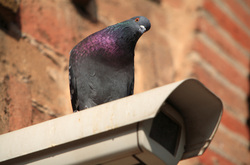 by Alex A. Kecskes
Today, more architects than ever are integrating pigeon control measures into their building designs. They know that the image of beautiful arches, clean lines and walls of glass can quickly be ruined by bird droppings. They also know that the acid in bird droppings can eat into wood, composites and even stone surfaces to permanently damage areas that were once showpieces of design. The fact is, many clients ask for references when contracting architects. The references are often in the form of completed projects. If these artistic creations are covered in bird droppings and their surfaces eaten away, they become useless as samples of one’s work—often to the point of excluding an architect from future bids. So the importance of effective pigeon control—or any bird control—for that matter, can’t be understated. Adding pigeon control and bird control services is an excellent way to round out an architectural firm’s repertoire of capabilities. The goal is to install effective pigeon control measures during the design-build process and to use low-profile humane deterrents that are easy to install and maintain. Keeping pigeons and other pest birds away from commercial, civil or large federal structures can be an added profit center for any architectural firm. When integrating pigeon control measures into an architectural design, one must take into account the aesthetics. Building materials and surfaces should be analyzed to ensure that the bird control methods minimally impact the overall structure. When enlisting the services of a bird control firm, that firm should offer products that are easy-to-specify. Any bird control repellents and/or deterrents used should meet the approval of local, state and federal agencies for humane operation. The products specified should be of the highest quality and be easy to “drop in” to projects specs. They should be backed by extensive warranties and the firm should offer support to help with the bird control designs. 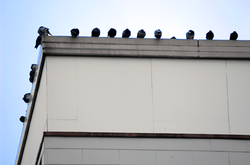 by Fran Prisco
Pigeons that are a pest in our cities and suburbs across the Nation are ancestors of the Rock Dove. Rock Doves built their nests high on rock cliffs, very similar to our city buildings of today. Pigeon nests are made up of loose twigs and other material that is found nearby. Along with nesting material, pigeons also leave behind a mess with their droppings and molted feathers. Each year building owners spend thousands to get rid of pigeons from their buildings. Clean up First Before installing any type of bird control system, it is important to do a thorough cleanup. It is best to power wash or spray bird droppings down and remove them while wet. Dried bird droppings can cause dust which when breathed in may carry any of 60 plus communicable diseases. Bird Droppings are also acidic and can quickly erode building and roofing materials, not to mention that they are a safety hazard on sidewalks, causing slip and fall accidents. 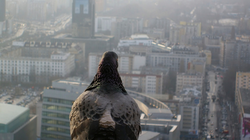 By Alex A. Kecskes
One of the many concerns facing today’s property managers is pigeon control. Pigeons are pest birds that remain unprotected by the Migratory Bird Treaty Act of 1918. They can cause property managers a lot of grief. So what attracts pest pigeons to a commercial building, its edifices and rooftops? A combination of factors. First off, commercial buildings usually offer covered areas that provide shelter from the elements. Things like rooftop AC units, electrical boxes, and ducting offer ideal places to nest and roost. Ledges and parapet walls offer high altitude perches for scouting predators and prey, especially if they overlook trash bins and dipsy-dumpsters. Also, if your commercial building is the only one in the area offering such vantage points, it will attract flocks of pest pigeons. Another attractive feature of your building may be that it lies close to ponds, fields, and electrical wires. And if you’re unlucky enough to have a flock of pigeons already nesting on your building, the droppings will attract other pigeons, making your building a prime gathering spot. In general, pigeons will be strongly attracted to nesting spots they have already claimed as their own. Without effective pigeon control measures, a pest pigeon infestation can result in costly and repetitive clean-ups. Long-term infestations. Can severely damage a commercial building’s facades, sills, parapet walls, roofing, water drainage systems and rooftop AC units. The annual damage/repair/cleanup cost of pest birds to commercial buildings is estimated to be in the hundreds of millions of dollars. 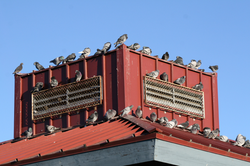 By Alex A. Kecskes
If you own a commercial building, you no doubt have had problems with pigeons. In most cases, the larger the building, the bigger the problem. For strip malls, commercial centers, warehouses and other large structures, pigeons can cause all sorts of headaches for property managers and property owners. If your building has a flat roof, pigeon debris, feathers and droppings can damage AC units, ventilators and drainage areas. Pigeons love to gather around rooftop equipment, and as you know, AC units are not cheap. They cost plenty to maintain and repair. Without proper pigeon control, pigeon debris can stop up rain vents and gutters, causing flooding. Hundreds or even thousands of gallons of water trapped on a long flat roof can lead to structural problems and ultimately roof collapse. Once this occurs, you have a huge problem in terms of damage to inventory inside a building. Whether your building is covered by a roof made of wood shingles or tiles, pigeons waste can be highly destructive. The acidic content of pigeon droppings can eat into the sub-roofing materials and eventually cause leaks. Bird droppings can also deface and damage your expensive signage—whether your signs are fabricated of metal, wood or plastic. Pigeons can also create an image problem. Bird droppings on entryways, walkways, display windows, benches, umbrellas and nearby lampposts can be a real turn off (and costly daily cleanups for you).  By Arlene Connelly
Many urban dwellers are unaware that more than 60 human diseases — including avian flu, salmonella, E coli and West Nile virus — are related to pigeons, other pest birds and their droppings. Besides being a public health issue in many cities, they often create a safety hazard for pedestrians, and they carry dangerous parasites and harmful bacteria. Some of these illnesses can even be fatal to humans; they can be contracted through contact with the skin and exposure through inhalation as people go about their daily activities. Why pest pigeons are especially dangerous Pigeons are generally considered to be “the number one bird pest” in America today, their numbers are increasing, and their nesting instincts are strong. They usually mate for life, live in communal flocks that travel together, and tend to roost where they can find adequate food and shelter. Along with that, experts in the field now consider pigeons to be a genuine “urban menace,” threatening the quality of life in America’s great cities, including San Francisco, Chicago and New York. Pigeon droppings can be found on walkways, roofs, window ledges and the sides of some of our finest buildings— anyplace these birds can access. This is especially dangerous around air vents and areas that surround water sources; the germs they carry can easily be transmitted to humans, especially those with a weakened immune system. They also attract insects that can spread disease as well, creating serious liability issues for businesses and restaurateurs. The corrosive affect of pest pigeon droppings results in extensive and expensive damage to our public buildings and monuments, and they can cause a serious disaster like the collapse of the Minnesota Bridge. Feathers, droppings and nest paraphernalia can also be sucked into pipes and vents, creating a fire hazard in a city’s high-rise buildings where people work and live. 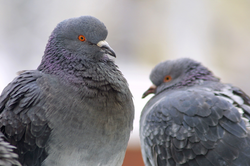 by Alex A. Kecskes
The ubiquitous pigeon has been man's friend and foe for centuries. Rising to nuisance level as they invaded our cities and towns, pest pigeons cause over one billion dollars annually in damage and cleanup costs. It's not surprising. Pigeon poop alone can cause all sorts of damage. It can eat into wood and metal, ruin fine stonework, and seize up AC units. Worse yet, pigeon poop is teaming with bacteria, fungi and parasites, which is why it poses such a high health risk. After all, pigeon droppings have been known to carry any of 60 known diseases. And no less hazardous are the fleas, mites and ticks that infest pigeons. It's no wonder that pigeon control has become so important. Thankfully, there are a number of highly effective pigeon control methods on the market.. One can't talk about pigeon control without mentioning the various Bird Scare products currently available. These flash tape banners wave, flap and crackle in the breeze to frighten pigeons looking for a safe place to land and roost. The same holds true for the inflatable, Bird Scare Balloon. Imprinted with menacing looking predator eyes, these devices turn and flail in the breeze to frighten pest pigeons away. 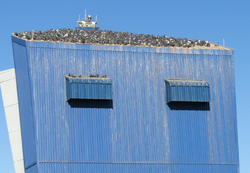 by Alex A. Kecskes
Pigeons have been both friend and foe to mankind for centuries. They have inspired poets and saved lives in wartime. But when they gather in great numbers in cities and towns, they can be most unwelcome. As a pest bird, they can also be most prolific. A single pair of pigeons can produce as many as 18 new pigeons every year--it only takes 19 days for a pigeon egg to hatch baby pigeons. Then, there are the droppings. One pigeon can generate up to 25 pounds of droppings every year, droppings that attract parasitic insects and flies. Droppings that can spread over 60 transmittable diseases to people and animals. According researchers of the Albert Einstein College of Medicine in New York, pigeon droppings can expose children to Cryptococcus Neoforman fungus. This is airborne fungus grows in rotting pigeon roots, and is present in pigeon droppings. The first step in controlling pigeon droppings is more effective pigeon control. Aside from disease, the highly acidic nature of pigeon droppings can destroy metal, paint and roofs. In fact, droppings and nests can present property owners with an ongoing repair bills to cover damages to gutters, shingles, AC units, skylights, and dish antennas. Thankfully, there are a number of highly effective pigeon control products currently available. Most are designed to discourage pigeons from landing and roosting. Moreover, these products have been carefully designed to avoid harming birds, animals and people. There are about 146,000 retail gas stations and convenience stores in the United States. That's the good news for late-night shoppers and folks running out of gas. The bad news is, many of these stores lack effective pigeon control, which means feral pigeons can pretty much do what they please. The last thing customers want to touch is a pump handle covered with pigeon poop. Or see the roof or hood of their car splattered with poop when they return with snacks in hand. These stores have a pigeon problem because the pesky little birds love to roost in gas station and store canopies. And they do so hundreds at a time. Without effective pigeon control measures, this often-neglected nuisance can cost commercial property owners thousands of dollars in maintenance and repairs. Keep in mind that just one healthy pigeon creates an average 66 pounds of droppings each year. If you've got a flock of these birds nesting in your gas station canopy, you're looking at several tons of poop over a short period of time. If you think the damage is all cosmetic, consider what happened to a gas station canopy in Yuma, Arizona. A build-up of pigeon poop clogged up the canopy's drains, causing it to crash to the ground after a heavy rain. A Hummer and a BMW were smashed in the process. Needless to say the gas station owner's insurance policy went up. Roosting and nesting pigeons can create an unsightly mess on signage, windows and gas pumps. They can clog drains, block out security cameras and jam doors and windows. They can also wreak havoc with rooftop AC units. As if that weren't enough to implement aggressive pigeon control measures, pigeon droppings are also breeding grounds for a number of diseases. Fecal droppings in pigeon infested canopies can create an environment for bacteria and fungi spores to grow and multiply. This filth can attract mites, black widows, rats, mice and other vermin. Consider the problems such an environment presents to a gas station that has a full-service food preparation kitchen. If you've got flocks of pigeons gathering on your rooftop or near air induction vents, these air conditioning and air circulation systems could easily suck in pigeon dander, spores and viruses. Cleaning roofs, parapets, HVAC, ventilation systems and other roosting sites can aerate these areas and increase the risks of exposure to disease. Gas station and store canopies offer the ideal place for pigeons—plenty of food in garbage cans and safe roosting areas. Failure to implement pigeon control measures can be very expensive in the long run—repairing a canopy can set you back as much as $100,000. And that doesn't include lost sales, city or health violation fees or full canopy replacement. Some effective pigeon control measures include bird netting, which works to effectively exclude the pests. You can also use chemical fogging systems to drive out entrenched flocks. Both measures are safe to use on pigeons and will save you a lot of grief and expense. |

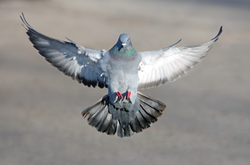
 RSS Feed
RSS Feed